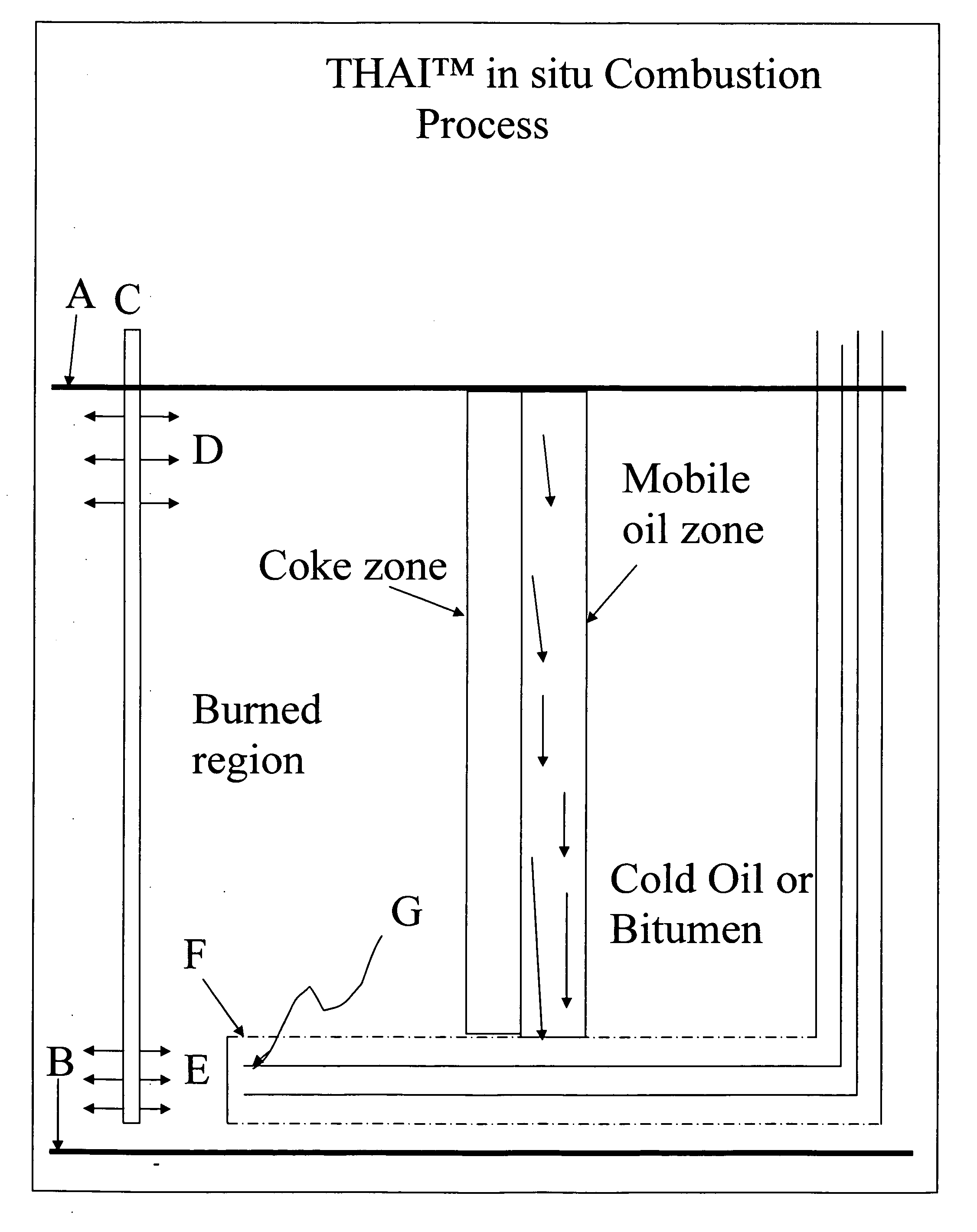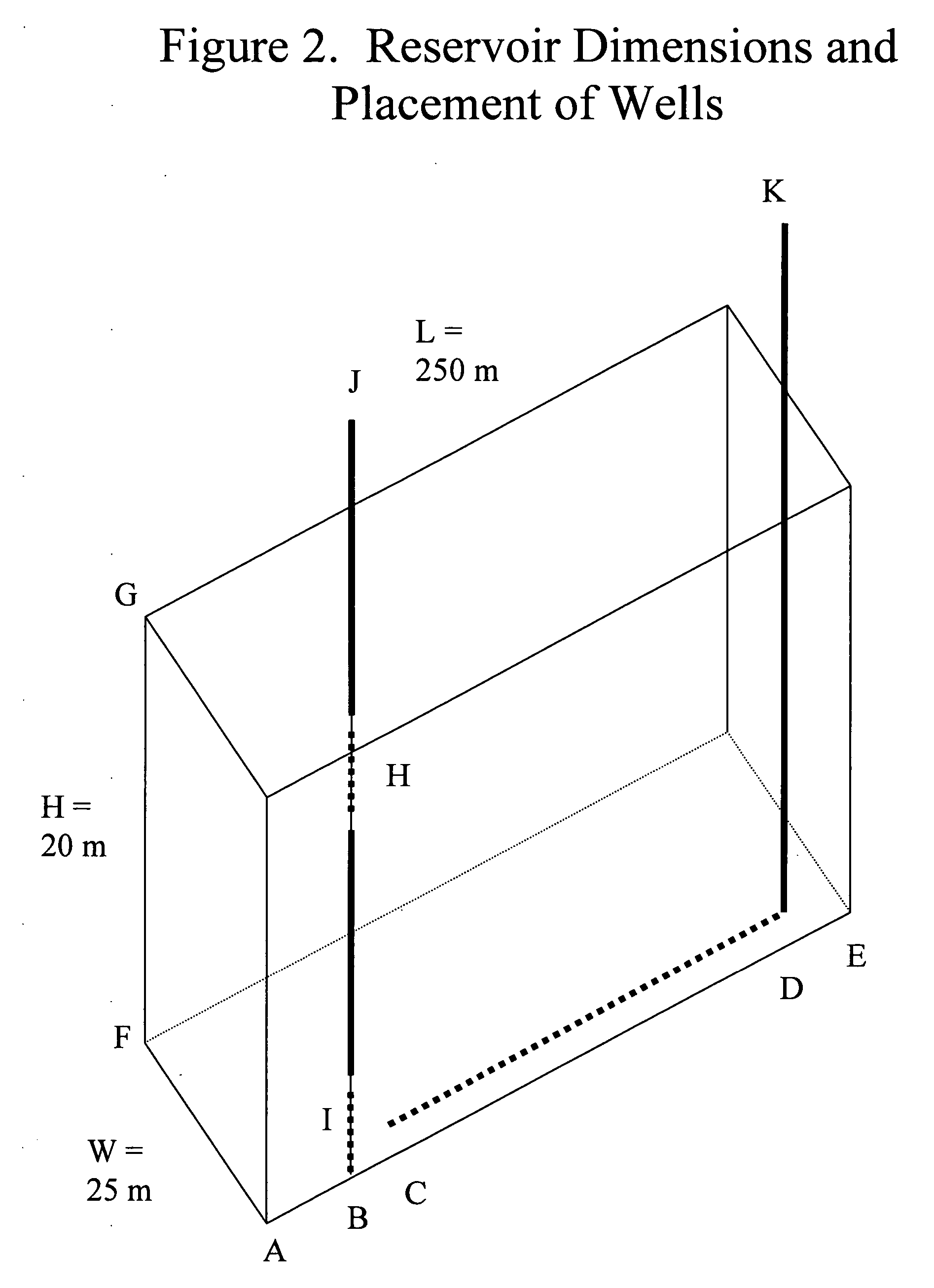Oilfield enhanced in situ combustion process
a combustion process and oilfield technology, applied in drinking water installation, wellbore/well accessories, construction, etc., can solve the problems of sand retention screen failure and irreparable damage to the wellbore, and achieve the effect of increasing the mobility of hydrocarbons, increasing the recovery rate, and adequate partial solubility
- Summary
- Abstract
- Description
- Claims
- Application Information
AI Technical Summary
Benefits of technology
Problems solved by technology
Method used
Image
Examples
example 1
[0109] Table 1a shows the simulation results for an air injection rate of 65,000 m3 / day (standard temperature and pressure) into a vertical injector (E in FIG. 1). The case of zero steam injected at the base of the reservoir at point I in well J is not part of the present invention. At 65,000 m3 / day air rate, there is no oxygen entry into the horizontal wellbore even with no steam injection and the maximum wellbore temperature never exceeds the target of 425° C.
[0110] However, as may be seen from the data below, injection of low levels of steam at levels of 5 and 10 m3 / day (water equivalent) at a point low in the reservoir (E in FIG. 1) provides substantial benefits in higher oil recovery factors, contrary to intuitive expectations. Where the injected medium is steam, the data below provides the volume of the water equivalent of such steam, as it is difficult to otherwise determine the volume of steam supplied as such depends on the pressure at the formation to which the steam is s...
example 2
[0111] Table 1b shows the results of injecting steam into the horizontal well via the internal tubing, G, in the vicinity of the toe while simultaneously injecting air at 65,000 m3 / day (standard temperature and pressure) into the upper part of the reservoir. The maximum wellbore temperature is reduced in relative proportion to the amount of steam injected and the oil recovery factor is increased relative to the base case of zero steam. Additionally, the maximum volume percent of coke deposited in the wellbore decreases with increasing amounts of injected steam. This is beneficial since pressure drop in the wellbore will be lower and fluids will flow more easily for the same pressure drop in comparison to wells without steam injection at the toe of the horizontal well.
TABLE 1bAIR RATE 65,000 m3 / day- Steam injected in well tubing.SteamInjectionMaximum wellMaximum cokeMaximum OxygenBitumen recoveryAverage oilRate m3 / dayTemperature,in wellborein wellboreFactorProduction(water equivale...
example 3
[0112] In this example, the air injection rate was increased to 85,000 m3 / day (standard temperature and pressure) and resulted in oxygen breakthrough as shown in Table 2a. An 8.8% oxygen concentration was indicated in the wellbore for the base case of zero steam injection. Maximum wellbore temperature reached 1074° C. and coke was deposited decreasing wellbore permeability by 97%. Operating with the simultaneous injection of 12 m3 / day (water equivalent) of steam at the base of the reservoir via vertical injection well C (see FIG. 1)provided an excellent result of zero oxygen breakthrough, acceptable coke and good oil recovery.
TABLE 2aAIR RATE 85,000 m3 / day- Steam injected at reservoir base.SteamInjectionMaximum wellMaximum cokeMaximum OxygenBitumen recoveryAverage oilRate m3 / dTemperature,in wellborein wellboreFactorProduction(water equivalent)° C.%%% OOIPRate m3 / day*01074978.8 55188001241443036.133.4
*Not part of the present invention.
PUM
 Login to View More
Login to View More Abstract
Description
Claims
Application Information
 Login to View More
Login to View More - R&D
- Intellectual Property
- Life Sciences
- Materials
- Tech Scout
- Unparalleled Data Quality
- Higher Quality Content
- 60% Fewer Hallucinations
Browse by: Latest US Patents, China's latest patents, Technical Efficacy Thesaurus, Application Domain, Technology Topic, Popular Technical Reports.
© 2025 PatSnap. All rights reserved.Legal|Privacy policy|Modern Slavery Act Transparency Statement|Sitemap|About US| Contact US: help@patsnap.com



